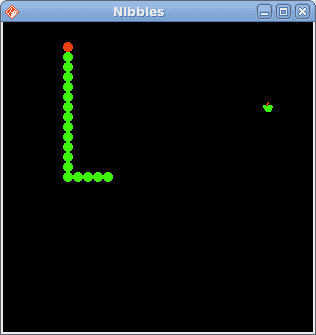在 QtJambi 编程教程的这一部分中,我们将创建一个贪食蛇游戏克隆。
贪食蛇是较旧的经典视频游戏。 它最初是在 70 年代后期创建的。 后来它被带到 PC 上。 在这个游戏中,玩家控制蛇。 目的是尽可能多地吃苹果。 蛇每次吃一个苹果,它的身体就会长大。 蛇必须避开墙壁和自己的身体。
开发
蛇的每个关节的大小为 10px。 蛇由光标键控制。 最初,蛇具有三个关节。 游戏立即开始。 游戏结束后,我们在窗口中心显示"Game Over"消息。
Board.java
package com.zetcode;import com.trolltech.qt.core.QBasicTimer;import com.trolltech.qt.core.QPoint;import com.trolltech.qt.core.QTimerEvent;import com.trolltech.qt.core.Qt;import com.trolltech.qt.gui.QColor;import com.trolltech.qt.gui.QFont;import com.trolltech.qt.gui.QFontMetrics;import com.trolltech.qt.gui.QFrame;import com.trolltech.qt.gui.QImage;import com.trolltech.qt.gui.QKeyEvent;import com.trolltech.qt.gui.QPaintEvent;import com.trolltech.qt.gui.QPainter;public class Board extends QFrame {private final int WIDTH = 300;private final int HEIGHT = 300;private final int DOT_SIZE = 10;private final int ALL_DOTS = 900;private final int RAND_POS = 29;private final int DELAY = 140;private int x[] = new int[ALL_DOTS];private int y[] = new int[ALL_DOTS];private int dots;private int apple_x;private int apple_y;private boolean left = false;private boolean right = true;private boolean up = false;private boolean down = false;private boolean inGame = true;private QBasicTimer timer;private QImage ball;private QImage apple;private QImage head;public Board() {setStyleSheet("QWidget { background-color: black }");setFocusPolicy(Qt.FocusPolicy.StrongFocus);ball = new QImage("dot.png");apple = new QImage("apple.png");head = new QImage("head.png");initGame();}private void initGame() {dots = 3;for (int z = 0; z < dots; z++) {x[z] = 50 - z*10;y[z] = 50;}locateApple();timer = new QBasicTimer();timer.start(DELAY, this);}@Overridepublic void paintEvent(QPaintEvent event) {super.paintEvent(event);QPainter painter = new QPainter();painter.begin(this);if (inGame) {drawObjects(painter);} else {gameOver(painter);}painter.end();}private void drawObjects(QPainter painter) {painter.drawImage(apple_x, apple_y, apple);for (int z = 0; z < dots; z++) {if (z == 0)painter.drawImage(x[z], y[z], head);else painter.drawImage(x[z], y[z], ball);}}private void gameOver(QPainter painter) {String msg = "Game Over";QFont small = new QFont("Helvetica", 12,QFont.Weight.Bold.value());QFontMetrics metr = new QFontMetrics(small);int textWidth = metr.width(msg);int h = height();int w = width();painter.setPen(QColor.white);painter.setFont(small);painter.translate(new QPoint(w/2, h/2));painter.drawText(-textWidth/2, 0, msg);}private void checkApple() {if ((x[0] == apple_x) && (y[0] == apple_y)) {dots++;locateApple();}}private void move() {for (int z = dots; z > 0; z--) {x[z] = x[(z - 1)];y[z] = y[(z - 1)];}if (left) {x[0] -= DOT_SIZE;}if (right) {x[0] += DOT_SIZE;}if (up) {y[0] -= DOT_SIZE;}if (down) {y[0] += DOT_SIZE;}}private void checkCollision() {for (int z = dots; z > 0; z--) {if ((z > 4) && (x[0] == x[z]) && (y[0] == y[z])) {inGame = false;}}if (y[0] > HEIGHT) {inGame = false;}if (y[0] < 0) {inGame = false;}if (x[0] > WIDTH) {inGame = false;}if (x[0] < 0) {inGame = false;}}private void locateApple() {int r = (int) (Math.random() * RAND_POS);apple_x = ((r * DOT_SIZE));r = (int) (Math.random() * RAND_POS);apple_y = ((r * DOT_SIZE));}@Overrideprotected void timerEvent(QTimerEvent event) {if (inGame) {checkApple();checkCollision();move();} else {timer.stop();}repaint();}@Overridepublic void keyPressEvent(QKeyEvent event){int key = event.key();if (key == Qt.Key.Key_Left.value() && !right) {left = true;up = false;down = false;}if ((key == Qt.Key.Key_Right.value()) && !left) {right = true;up = false;down = false;}if ((key == Qt.Key.Key_Up.value()) && !down) {up = true;right = false;left = false;}if ((key == Qt.Key.Key_Down.value()) && !up) {down = true;right = false;left = false;}}}
首先,我们将定义一些在游戏中使用的全局变量。
WIDTH和HEIGHT常数确定电路板的大小。 DOT_SIZE是苹果的大小和蛇的点。 ALL_DOTS常数定义了板上可能的最大点数。 RAND_POS常数用于计算苹果的随机位置。 DELAY常数确定游戏的速度。
private int x[] = new int[ALL_DOTS];private int y[] = new int[ALL_DOTS];
这两个数组存储蛇的所有可能关节的 x,y 坐标。
initGame()方法初始化变量,加载图像并启动超时功能。
if (inGame) {drawObjects(painter);} else {gameOver(painter);}
在paintEvent()方法内部,我们检查inGame变量。 如果为真,则绘制对象。 苹果和蛇的关节。 否则,我们显示"Game Over"文本。
private void drawObjects(QPainter painter) {painter.drawImage(apple_x, apple_y, apple);for (int z = 0; z < dots; z++) {if (z == 0)painter.drawImage(x[z], y[z], head);else painter.drawImage(x[z], y[z], ball);}}
drawObjects()方法绘制苹果和蛇的关节。 蛇的第一个关节是其头部,用红色圆圈表示。
private void checkApple() {if ((x[0] == apple_x) && (y[0] == apple_y)) {dots++;locateApple();}}
checkApple()方法检查蛇是否击中了苹果对象。 如果是这样,我们添加另一个蛇形关节并调用locateApple()方法,该方法将随机放置一个新的Apple对象。
在move()方法中,我们有游戏的关键算法。 要了解它,请看一下蛇是如何运动的。 您控制蛇的头。 您可以使用光标键更改其方向。 其余关节在链上向上移动一个位置。 第二关节移动到第一个关节的位置,第三关节移动到第二个关节的位置,依此类推。
for (int z = dots; z > 0; z--) {x[z] = x[(z - 1)];y[z] = y[(z - 1)];}
该代码将关节向上移动。
if (left) {x[0] -= DOT_SIZE;}
将头向左移动。
在checkCollision()方法中,我们确定蛇是否击中了自己或撞墙之一。
for (int z = dots; z > 0; z--) {if ((z > 4) && (x[0] == x[z]) && (y[0] == y[z])) {inGame = false;}}
如果蛇用头撞到关节之一,我们就结束游戏。
if (y[0] > HEIGHT) {inGame = false;}
如果蛇击中了棋盘的底部,则游戏结束。
locateApple()方法在板上随机放置一个苹果。
int r = (int) (Math.random() * RAND_POS);
我们得到一个从 0 到RAND_POS-1的随机数。
apple_x = ((r * DOT_SIZE));...apple_y = ((r * DOT_SIZE));
这些行设置了apple对象的 x,y 坐标。
if (inGame) {checkApple();checkCollision();move();} else {timer.stop();}
每 140 毫秒,将调用timerEvent()方法。 如果我们参与了游戏,我们将调用三种构建游戏逻辑的方法。 否则,我们将停止计时器。
在Board类的onKeyPressEvent()方法中,我们确定按下的键。
if (key == Qt.Key.Key_Left.value() && !right) {left = true;up = false;down = false;}
如果单击左光标键,则将left变量设置为true。 在move()方法中使用此变量来更改蛇对象的坐标。 还要注意,当蛇向右行驶时,我们不能立即向左转。
Nibbles.java
package com.zetcode;import com.trolltech.qt.gui.QApplication;import com.trolltech.qt.gui.QMainWindow;/*** ZetCode QtJambi tutorial** In this program, we create* a Nibbles game clone.** @author jan bodnar* website zetcode.com* last modified April 2009*/public class Nibbles extends QMainWindow {public Nibbles() {setWindowTitle("Nibbles");resize(310, 310);setCentralWidget(new Board());move(300, 300);show();}public static void main(String[] args) {QApplication.initialize(args);new Nibbles();QApplication.exec();}}
在这个类中,我们设置了贪食蛇游戏。

图:贪食蛇
这是使用 QtJambi 库编程的贪食蛇电脑游戏。

